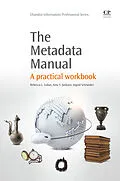Cultural heritage professionals have high levels of training in metadata. However, the institutions in which they practice often depend on support staff, volunteers, and students in order to function. With limited time and funding for training in metadata creation for digital collections, there are often many questions about metadata without a reliable, direct source for answers. The Metadata Manual provides such a resource, answering basic metadata questions that may appear, and exploring metadata from a beginner's perspective. This title covers metadata basics, XML basics, Dublin Core, VRA Core, and CDWA schemes and provides exercise in the creation of metadata. Finally, the book gives an overview of metadata, including mapping and sharing. - Outlines the most popular metadata schema written by practicing metadata librarians - Focuses on what you "need to know - Does not require coding experience to use and understand
Autorentext
Rebecca L. Lubas is Director, Cataloguing and Discovery Services at the University of New Mexico Libraries, where she coordinates a group of catalogers. Rebecca was previously Head of Cataloging and Metadata Services and Special Formats Cataloger at the Massachusetts Institute of Technology (MIT) Libraries, and a founding member of the Metadata Services Unit at MIT. Rebecca holds an MA in English Literature from Ball State, an MLIS from Louisiana State University, and a BA from the University of Notre Dame, USA. She is the Editor of Practical Strategies for Cataloguing Departments.
Inhalt
List of figures and tables
List of abbreviations
Acknowledgements
Foreword
Preface
About the authors
Chapter 1: Introduction to metadata
Abstract:
Introduction
What is metadata?
History of metadata
The types and structure of metadata
Metadata languages
Quality control and interoperability
Where to go for more information
Chapter 2: XML basics
Abstract:
What is XML?
How are XML records created?
Other content in XML
Well-formed vs. valid XML
Why do we use XML?
XML example records
Example exercise
Chapter 3: Using Dublin Core: With information from the Dublin Core Metadata Initiative
Abstract:
Background/History
Changes to Dublin Core
The DCMI Metadata Terms
Example record
Exercises
Answer key
Chapter 4: Using Encoded Archival Description (EAD): With information from Encoded Archival Description Tag Library, Version 2002, by the Society of American Archivists
Abstract:
Introduction
Development
Elements
Example EAD record (abbreviated)
Exercise
Answer key
Chapter 5: Using Categories for the Description of Works of Art (CDWA) and CDWA Lite: With information from the Getty Institute
Abstract:
Introduction
CCO (Cataloging Cultural Objects)
Elements
Exercises
Answer key
Chapter 6: Using VRA Core 4.0
Abstract:
Introduction
Development of VRA Core
VRA Core 4.0 elements
Example record
Exercises
Answer key
Chapter 7: The big picture
Abstract:
Introduction
Shareability
The semantic web
RDF Exercises
Making records shareable
Mapping and crosswalking
XSLT
OAI-PMH
Exercises
Conclusion
Where to go for more information
Answer key
Shareability exercise
OAI-PMH exercise
Appendix: XML examples
References
Index
